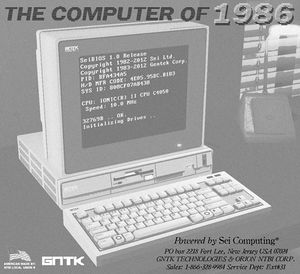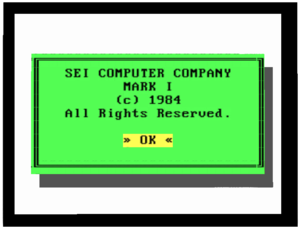Mark 1
The Mark 1 (previously Mark I) is a computer hardware platform in development by NBS. It is the first and only fully-functional graphical computer capable of operating entirely on LSL.
Origins
The Mark 1 was first spawned in December 2011 by Nelson Jenkins with assistance from Will Szymborska. The idea of an individual-character display was thrown around for years, but wasn't technically feasible until recently due to newer LSL functions and mesh construction possibilities. Adel Button assisted by designing the character display object, which was scripted in only a few hours late at night. The first design ever displayed on the Mark I display was a green SeiOS dialog box with a drop shadow. The casing and peripherals were made in the following weeks, along with the core of SeiOS.
Originally the display was going to be 40x20 characters, which would have been 50 prims land impact. However, the display was sized down to 32x15 characters, which reduced the land impact cost considerably. However, after Sei Computing was transferred to NBS, the display driver was redesigned which allowed for 48x20 characters, as well as foreground and background colors for each character cell. The new display driver, named "TrueColor", also sharpened the display characters and added the capability for monochrome displays. This display driver was made possible by the use of an attachment for the display object, which also reduced the prim count of the computer dramatically.
As of 2016, the Mark 1 is being redesigned with a new case and a new operating system. The operating system will implement a more adaptable program manager so that the computer operates much more realistically.
Hardware
The Mark 1's hardware is as follows (system calls):
- 960-character 16-color display w/ multi-tile sprite support
- 22 kB hard disk
- 22 kB hot-swappable floppy disk drive
- Expandable cloud storage for faster operations (capacity TBD)
- 10 MHz optimum processor clock rate
- 256 kB of RAM
- Up to 16 component connections
- 87-key keyboard with direct (gesture) and indirect (touch) input support
- 10 Mbit/s Ethernet local network card (same-region communications only)
Additionally, add-on components provide the following hardware:
- 60 cps / 60 dpi dot-matrix printer
- Dual 40 kB floppy disk drives + dual 40 kB hard disk "databox" external drive
- 14.4 kbit/s modem compatible with SeiNet Protocols gridwide
The DS/200 Server also provides a 40 kB hard disk and 40 kB floppy disk drive for network use.

